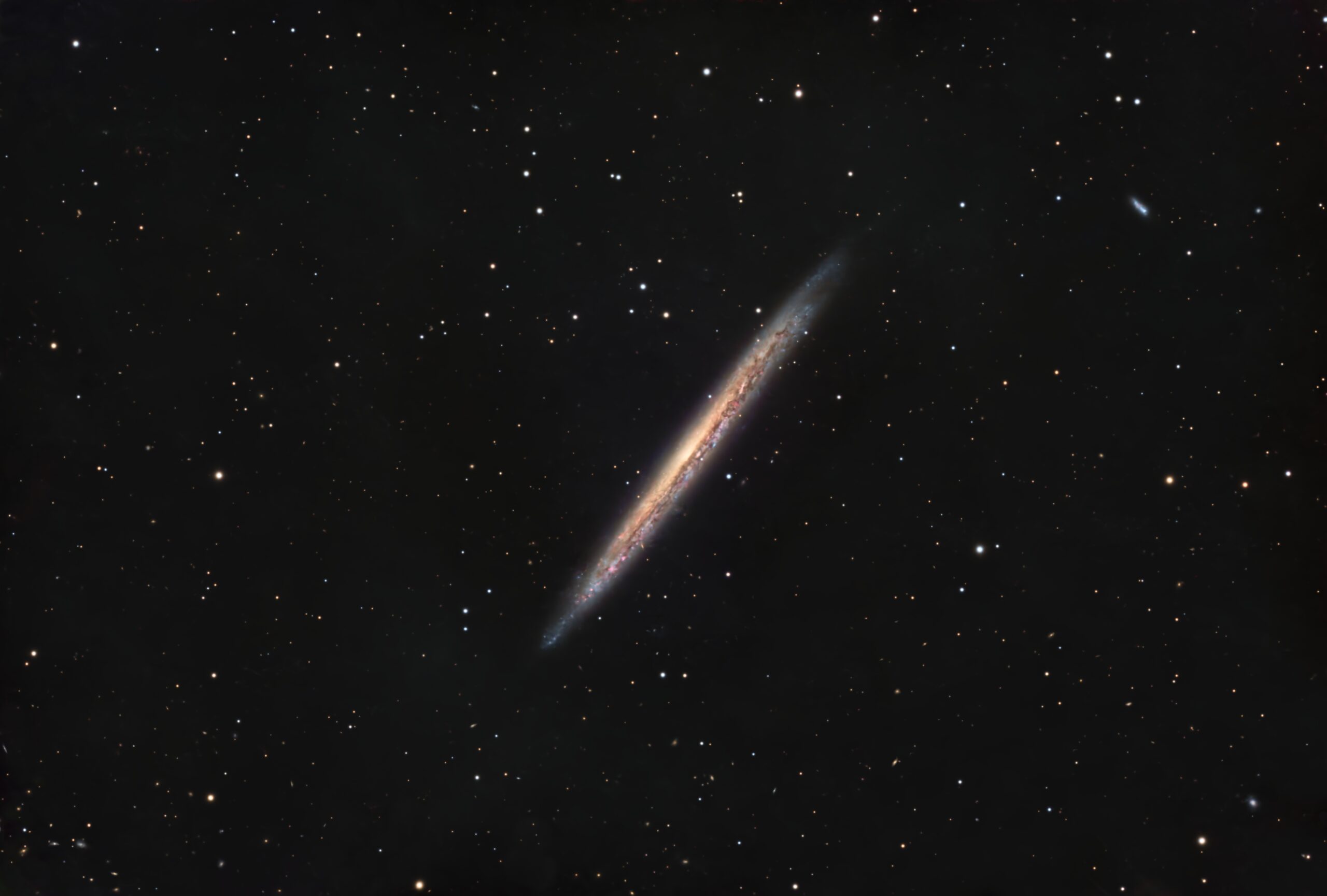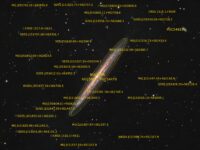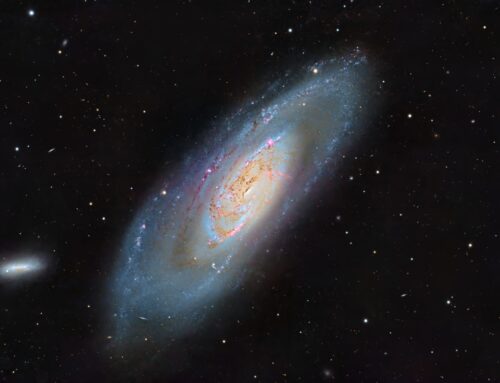NGC 5907, the Splinter Galaxy

Click image for full size version
May 24, 2025
This spring gem is NGC 5907, the Splinter Galaxy (also called the Knife Edge Galaxy). It’s sometimes catalogud as NGC 5906. This galaxy is located more than 50 million light years away in the constellation Draco. Through a large telescope, it looks to me like a toothpick. The photo brings out much more detail, including a bright core, hot pink H-alpha knots, and prominent dark dust lanes. The Splinter Galaxy is made up mostly of white dwarf stars — small, dense stars nearing the end of their lives. They eventually lose all their heat and ability to fuse elements, and get cold and dark, like a cinder.
Many other galaxies share this field with NGC 5907. The most prominent is PGC54419 at upper right. Most of the other galaxies in the image are extremely distant quasars, and are highlighted in an annotated image.
Tekkies:
Acquisition, focusing, and control of Paramount MX mount with N.I.N.A., TheSkyX and PHD2. Primalucelab low-profile 2″ Essato focuser and ARCO rotator. Guiding with PHD2. Equipment control with PrimaLuce Labs Eagle 4 Pro computer. Flats taken using a Primalucelab Giotto 430 mm flat panel. All pre-processing and processing in PixInsight. Acquired from my SkyShed in Guelph. Data acquired under a nearly full Moon with average or better transparency and and average seeing between May 9 – 15, 2025.
Celestron 14″ EDGE HD telescope at f/11 (3,912 mm focal length) and QHY600M camera binned 2×2 with Optolong filters.
78 x 5m Red = 6hr 30m
78 x 5m Green = 6hr 30m
77 x 5m Blue = 6hr 25m
20x 5m Ha = 1hr 40m
Total: 21hr 05m
Preprocessing: The WeightedBatchPreProcessing script was used to perform calibration, cosmetic correction, weighting, registration, integration and Drizzle integration of all frames (1x drizzle, 0.9 Drop Shrink).
RGB and SynthL masters: A master RGB image was made from the Red, Green and Blue Drizzled masters using ChannelCombination in RGB mode. A synthetic luminance (SynthL) master was made from all four masters using ImageIntegration with weighting by SNR.
Gradient Removal: Spectrophotometric Flux Calibration followed by Multiscale Gradient Correction was applied to the RGB master. DynamicBackgroundExtraction was applied to the SynthL and Ha masters.
Colour Calibration: BlurXterminator was applied to the RGB master with Correct Only selected, followed by ColorCalibration.
Deconvolution: BlurXterminator was applied to the RGB, SynthL, and Ha masters with Automatic psf , star sharpening set to 0.5, and non-stellar set to 0.9.
Linear Noise Reduction: NoiseXterminator was applied to the RGB, SynthL, and Ha masters with settings Amount=0.9 and Detail=0.25.
Ha Continuum Subtraction: The ContinuumSubtraction script, by Jurgen Terpe, was used to remove continuum emissions from the Ha master using the red channel of the RGB master as the continuum reference image.
Stretching: HistogramTransformation was applied to make a pleasing image from the RGB, SynthL, and Ha masters. Approximate background level after stretch was 0.1 for SynthL and 0.08 for the Ha and RGB masters.
Nonlinear Processing
Luminance-RGB addition: LRGBCombination was applied to replace the lightness of the RGB image with the Luminance master.
Star Removal and processing: StarXterminator was used to remove the stars from the LRGB and Ha masters with Unscreen checked. The Ha stars were discarded. Colour was increased in the LRGB stars-only image by applying Curves saturation through a star mask.
Initial Saturation Boost: CurvesTransformation’s saturation tool was used to boost colour in the galaxies in the starless LRGB image using a range mask made with RangeSelection to protect the background.
H-alpha Blending: The contiuum-subtracted Ha was added to the LRGB image using Jurgen Terpe’s CombineHaWithRGB script.
Nonlinear Noise Reduction: NoiseXterminator was applied to the HaLRGB image with settings Amount=0.9 and Iterations=5. SCNR was applied (Green; average neutral, 50%) using a mask to select only the galaxy.
Contrast Enhancement: Jergen Terpe’s CreateHDRImage script was applied to compress the dynamic range of the galaxy slightly. LocalHistogramEqualization was then applied twices. A Contrast Limit of 1.5 and 1 iteration was used for each application (scale 40, strength 0.25, scale 140, strength 0.25).
Sharpening: MultiscaleMedianTransform was used to sharpen Layers 1 – 5 with strengths of 0.03, 0.03, 0.03, 0.02, and 0.01, respectively.
Star Restoration: Stars were added back into the image using the PixelMath expression combine(starless, stars_only, op_screen())
Final Steps: Background, galaxy, and star brightness, contrast, and saturation were adjusted in several iterations using CurvesTransformation with masks as required. ICCProfileTransformation (sRGB IEC61966-2.1; Relative Colorimetric with black point compensation) was applied prior to saving as a jpg. The finder chart was made using the FindingChart process.








Awesome work sir!
Thank you!